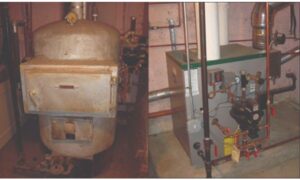Refrigerant is a medium for conveying heat. Air conditioners transfer heat while circulating refrigerant between the indoor and outdoor units. Refrigerants used in refrigeration and air conditioning systems must be used properly to avoid potential hazards.
R-32 is a new refrigerant and is currently receiving the most interest. Because R-32 efficiently conveys heat, it can cut down electricity consumption up to approximately 10 percent, compared to that of air conditioners using refrigerant R-22. Furthermore, compared to the refrigerants widely used today such as R-22 and R-410A, R-32 has a global warming potential (GWP) that is one-third lower and is remarkable for its low environmental impact.
R-32 is a next generation refrigerant that efficiently carries heat and has lower environmental impact. R32 refrigerant is also known as difluoromethane and belongs to the HFC family of refrigerant. This gas is poised to replace the other gaseous such as R-410A and R-407C as the preferred gas due to its lower Global Warming Potential. Its chemical formula is CH2 F2.
R410A refrigerant in 2006, as it offered higher efficiencies, achieved by operating at higher pressures and the introduction on inverter technology in DX split systems. It also replaced R22 refrigerant which was banned because of its potential to damage the ozone layer and the HFC R407C. R410A though is a hydrofluorocarbon (HFC) and partly responsible for the greenhouse effect on the Earth. In 1999 the Kyoto Protocol on global warming listed HFC refrigerants that were contributing to global warming.
This in turn led to the introduction in Europe of the F-Gas Regulations and at the start of January 2015, the next stage of the F-Gas laws was introduced which detailed the phase down of HFC refrigerant.
Most refrigerants have low boiling points and present dangers of frostbite and eye damage. Refrigerant liquids with higher boiling points can cause respiratory and skin irritation. Refrigerants can also damage the environment if handled improperly. In the mid-1970s it was suggested that Freon and other CFCs were, by chemical reaction, destroying the ozone present in the stratosphere. Depletion of the ozone could create a threat to animal life on the Earth because the ozone absorbs ultra-violet radiation that can induce skin cancer. The use of Freon in aerosol-spray containers was banned in the United States in the late 1970s. By the early 1990s, accumulating evidence of ozone depletion in the Polar regions had heightened worldwide public alarm over the problem, and in 1992 most of the developed nations agreed to end their production of Freon and other CFCs by 1996.
Characteristics of R32
R32 refrigerant gas is pure HFC with zero impact on ozone layer and has global warming potential. It is usually used in its pure form, essentially in small air-conditioners and refrigeration.
Some of the essential characteristics of R32 are –
- It is an energy efficient refrigeration than R-410A with GWP of 675; equivalent to 68 percent lower than R-410 A
- Its refrigeration capacity is similar to that of R-22 and R-502
- It requires less refrigerant charge compared to R-410A
- Same tubing and POE oils as R-410A
- Safety classification: A2L, low toxicity and low inflammable
The Benefits
- Zero ODP
- One third of R-410A GWP
- Required less charge as it has a 20 per cent higher volumetric capacity
- Similar saturated pressure hence development is easier
- Higher critical temperature hence higher COP
- Lower density hence the amount of charge required is smaller
- Single component of gas, therefore it is easier to be produced and managed
The Disadvantages
- Toxicity level slightly higher and more precaution is needed to use it
- Higher discharge temperature will cause oil degradation in the compressor which may damage some of the components in it. Design consideration is required to ensure the discharge temperature is limited to an acceptable level
- This refrigerant is definitely more environmental friendly and its use should be encouraged at all levels beginning with the governing
- authorities. It is a good replacement refrigerant for R22 and R410A.
Comparison of R32 with R410
- Saturated pressure: R32 has a similar pressure as R410A. This can ease the development on an R32 system based on an R410A platform.
- Critical temperature: R32 has a higher critical temperature which yields a higher COP.
- Latent heat of vaporisation: The heat needed to evaporate R32 is greater than that of R410A so that the required mass flow rate per unit cooling capacity is smaller and the COP is higher.
- Isentropic exponent: This can impact the pressure ratio of the system and also the discharge temperature. So R32’s pressure ratio is a little higher than R410A.
- Volumetric cooling capacity: R32 has got a significantly higher volumetric cooling capacity than R410A, which can help to reduce the system pipe size and increase the efficiency.
- Density: R32’s density is much smaller than R410A, so the amount of charge is smaller, and since the GWP is measured per kg, the total climate impact from the refrigerant in the system is even smaller than suggested by the GWP.
From the above mentioned, R410A, R32 has a better system efficiency, and it needs a smaller refrigerant charge. The significant problem is that R32 has a high discharge temperature. Its direct consequence is the oil degradation which can cause various compressor failures like bearing seizure, low system and compressor efficiency. So the discharge temperature should be limited at an acceptable level to make sure that system and compressor could work normally. Usually is to control discharge temperature by refrigerant. Liquid injection could be a good solution for high discharge temperature directly. A portion of the condensed fluid is injected into scroll through an electronic injection valve, which will absorb the heat of intermediate compressed gas to vaporise. Thus the discharge temperature can be lower down effectively. And the injected mass flow rate can be easily modulated by injection valve.
Cookie Consent
We use cookies to personalize your experience. By continuing to visit this website you agree to our Terms & Conditions, Privacy Policy and Cookie Policy.















